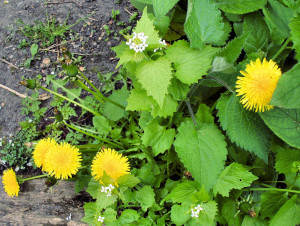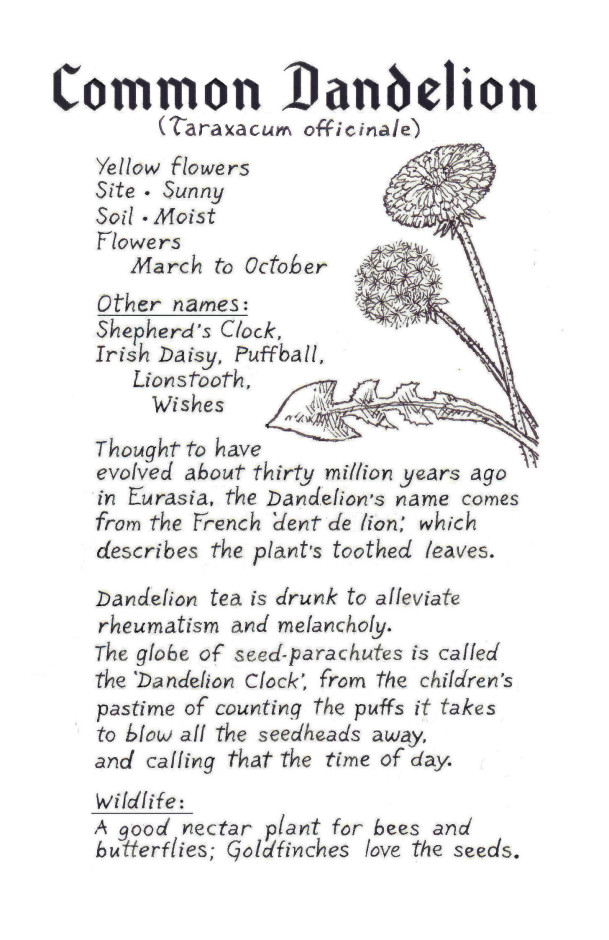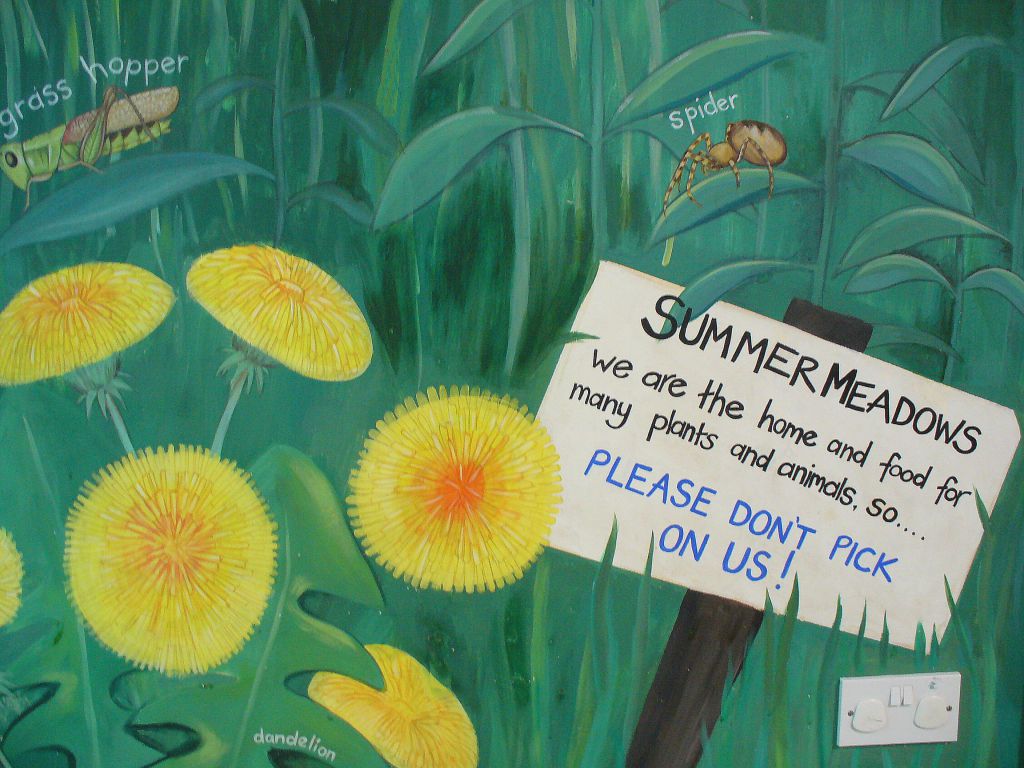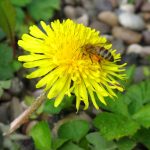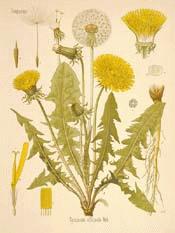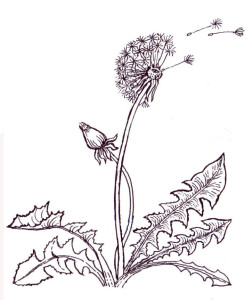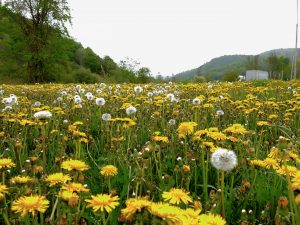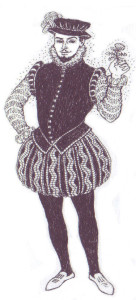DANDELION (Taraxacum officinale)
Eurasia
The familiar bright yellow of the Dandelion is unwelcome in most gardens. If this wildflower appears on your patch, it will most likely have come as a seed blown on the breeze, not one planted by yourself from a seed packet.
The Dandelion is an annual whose flowers close overnight, & during rain. It has prodigious properties of reproduction… Dandelion roots are notoriously difficult to dig up, & any bit of root left in the ground will grow into another Dandelion.
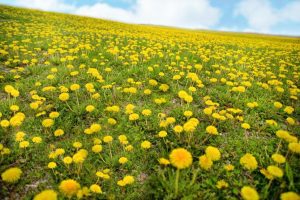
Horticultural
‘Loosening compacted soil by growing deep roots, creating a micro-climate that draws earthworms, whose job it is to change and rejuvenate the soil, drawing nutrients and toxins to the surface for use and transformation, dandelion is symbolic of the kind of magic that gently and firmly changes those conditions that no longer serve its environment.’
The Practical Herbalist, posted by Candace Hunter, https://
thepracticalherbalist.com/advanced-herbalism/dandelion-history-folklore-myth-and-magic/
From Floralogic, Ontario, Canada – Tasha the Amazon:
Bees Favourite, Wildlife
In a woodland garden, or part of a garden left to grow wild, the plant can be appreciated for its wildlife-friendly qualities. Butterflies ( Peacock, Speckled Wood, Orange Tip & Brimstone ), bees & other insects visit the Dandelion for its nectar.
Beetles & moths ( Buff Ermine, The Shears, Cream Wave, Great Brocade, Gold Swift, Clouded Buff, Northern Rustic ) use taraxacum as a food plant.
Traditional
In the Victorian Language of Flowers, the Dandelion was given the identity of ‘Rustic Oracle’.
“The ingratitude shown to the dandelion is almost unbelievable. We should be inviting it in to our gardens with low bows, rather than uprooting it with imprecations. Few gardeners take note of that word officinale, which points to the fact that the dandelion should be treated with respect as a herb used in medicine.
Perhaps if we mentioned in passing to our neighbours that our Taraxacums were doing well this year, we might do a little to reinstate what is, after all, quite a handsome flower. But no, its old-fashioned names of Piss-a-bed in the United States and England, and Pissenlit in France, would rise, a guilty secret from the past, to SMIRCH its already tarnished good name…”
“Dandelion wine is famous for its potency, but dandelion coffee is, well, dandelion coffee.”
Lesley Gordon, Green Magic–Flowers, Plants & Herbs in Lore & Legend, Ebury Press, Webb & Bower Ltd, Exeter.
It is a sure sign of rain when the down blows off the dandelion while there is no wind: and to blow the seeds off a dandelion is to carry one’s thoughts to a loved one.’
Jeanne Rose, Herbs & Things/Jeanne Rose’s Herbal, Grosset & Dunlap, Workman Publishing Company, New York 1973.
Herbal, Medicinal
The Dandelion was referred to as ‘blessed medicine’ in the 18th century in Europe. Native to Greece, used as food and medicine throughout the world but more so in Germany, China and England. Arabian physicians of the middle ages first officially recognised the plant’s medicinal properties and named it Taraxacon from the Greek taraxos ‘disorder’ and ‘akos’ for ‘remedy’.
The plant was used medicinally in China for over 1,000 yrs as a treatment for breast cancer, for diseases of the liver, gall and spleen. English botanist Nicholas Culpeper (1616-1654) said it was used to treat jaundice and urinary infections. Traditionally dug up by French-Canadians in its second season, to use the roots . Icelanders did the same, and fried the roots. In eastern medicine, they traditionally used Dandelion to heal liver complaints. They also used the coarsely ground root to heal snake bites and to inhibit the growth of tumor cells in a mixture along with kelp and gotu kola.
Jennifer Heinzel, in the garden/discovering dandelion uses, mother earth living.
Henry VIII ate dandelion to calm his stomach after lush feasts. https://www.buildingbeautifulsouls.com/symbols-meanings/flower-meanings-symbolism/daisy
From Danu’s Irish Herb Garden, Connemara, Ireland : Terri Conroy
Doctrine of Signatures: Dandelion is examined in That Signature Look: An Introduction to The Doctrine of Signatures, Allaire Diamond, Conservation ecologist with the Vermont Land Trust, 2914. . https://northernwoodlands.org/articles/article/doctrine-signatures
Myth, Magic, Folklore
16th century Herbalist Matthiolus: “Magicians say that if a person rubs himself all over with (the decoction of the whole plant), he will everywhere be welcome and obtain what he wishes” (!)
NATURE’S FORGOTTEN FOLKLORE: MYTHS and MAGIC in ISLINGTON, Richard Meyers for Islington Council
From Story Crow, Wiltshire, UK : Oliver Lavery
Other names: Barbed Arrows and Fishhooks, Blowball, Butter Flower, Canker Wort, Chiang Nou Ts’Ao, Chin Tsan Ts’Ao, Combs and Hairpins, Conquer Moors, Crow-parsnip, Dashel, Dazzle-flower, Devil’s Milkpail, Dierite De Leon, Dirt-abed, Dmuchawiecz, Farmer’s Clocks, Fortune-teller, Gewone Paardebloem, Golden Sun, Gramfer Griggle-sticks, Irish Daisy, Kara Hindiba, Lady of Spring, Lie-a-Bed, Lion’s Teeth, Miecz, Monkshead, One O’Clocks, Four O’Clock, Peasant’s clock, Pisacan, Priest’s Crown, Puffball, Pusteblume, Schrank, Soffione, Stink Davie, Swine’s Snout, Twelve O’clock, Wild Endive, Wild William, Worm Rose.
This experience of the dandelion was posted to the Plant-Lore website:
“I grew up in New Zealand (born 1944) where dandelions are considered the lawn-grower’s enemy. Very surprised to be served them in France in 1973 as a salad. Salade de pissenlits with a good vinaigrette is considered quite a delicacy – seasonal, of course. I loved it but I can understand that children would not like the bitter taste”. [e-mail, Australia, January 2013].
http://www.plant-lore.com/?s=dandelion
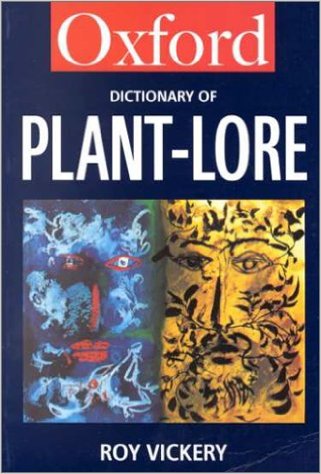
Plant-Lore is an Archive of local names, herbal remedies, sayings, riddles, tales, legends & more. Botanist, lecturer & author Roy Vickery, The Compiler of the Archive, was born in rural Dorset but now lives in South London. He is available for walks & talks. You provide the weed patch, he will do the rest.
Roy welcomes information on plants from all parts of the British Isles, ethnic groups settled in the British Isles, & comparative material from overseas, no matter how widespread and well-known you consider it to be. A copy of all material received will eventually be placed in the care of the library of The Natural History Museum.
www.plant-lore.com/ Plant-Lore. Collecting the folklore & uses of plants
Roy Vickery, 9 Terrapin Court, Terrapin Road, London SW17 8QW.
